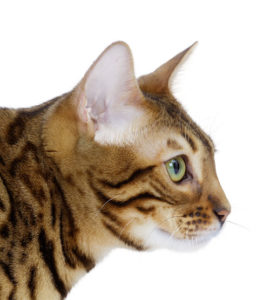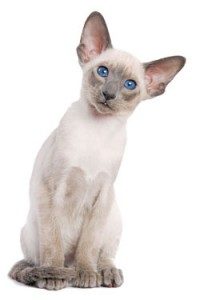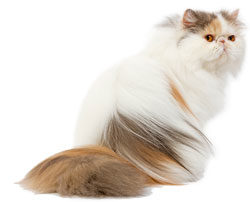Your Cat’s Physical Characteristics
Do you think all cats have roughly the same shape, size and appearance? If so, you’d better think again! When choosing the right breed for you, it is important to consider several factors.
Firstly, you must evaluate the size of the cat you want. Certain breeds, such as the Maine Coon, grow to become much larger than your average 4-5kg moggy. They have a much larger bone structure, frame and tail and take much longer to reach adulthood, so their growth period needs to be supported well beyond the age of 6-12 months. When compared to a breed such as the tiny Singapura, unlikely to reach more than 3.5kg in weight at the most, you realise the true diversity you are dealing with.
 Secondly, you need to consider the type of coat you’d like your cat to have. Short-haired cats, such as the British Shorthair, whilst still in need of regular coat care, are generally much easier to manage than their longer-haired companions, which may need grooming every day to prevent knots and mats developing. Some breeds, such as the Sphinx, even have no hair but don’t be fooled into thinking this makes them easy to look after. They generally need extra attention to prevent them from becoming too cold and are more prone to injuries that fur would otherwise protect them from, such as scratches and bites from other cats. Other breeds, such as the Ragdoll, have an intermediate type of silky coat, which is often described as “semi-longhair”.
Secondly, you need to consider the type of coat you’d like your cat to have. Short-haired cats, such as the British Shorthair, whilst still in need of regular coat care, are generally much easier to manage than their longer-haired companions, which may need grooming every day to prevent knots and mats developing. Some breeds, such as the Sphinx, even have no hair but don’t be fooled into thinking this makes them easy to look after. They generally need extra attention to prevent them from becoming too cold and are more prone to injuries that fur would otherwise protect them from, such as scratches and bites from other cats. Other breeds, such as the Ragdoll, have an intermediate type of silky coat, which is often described as “semi-longhair”.
Thirdly, consider the sort of stance and facial characteristics you’d appreciate in your cat. These traits are highly defined within the different breeds. Popular breeds, such as the Persian, have a very typical look about their faces, with wide-set ears and large eyes, which can make them very endearing.
Your Cat’s Personality
Whilst every loveable feline will have a unique personality all of its own, certain idiosyncrasies can really be exaggerated in specific breeds. Therefore, it is important that you take personality into account, before you consider acquiring a pedigree. If you’d love a cat that is highly intelligent and can’t wait to “chat” and interact all day long, the vocal and sociable Siamese would be a great choice. If you’re looking for a much more relaxed and laid-back cat, why not consider the Ragdoll, with its docile, gentle temperament?
Extra Tips
When considering a pedigree feline, make sure you deal with reputable breeders. They will have their cats officially registered and you can check with them that your new pet has had optimal care before you pick it. Things to ask the breeder about include the nutrition, worming and vaccination status of the mother and the kitten you are purchasing. Don’t be afraid to ask the breeder for references from other purchasers as well. You may even want to consider acquiring a pedigree through a breed rescue scheme and there are many ways to go about this but you could look to national cat fanciers associations (such as the Governing Council of the Cat Fancy) for further information.
Many potential owners also worry that pedigree cats may be more prone to certain medical issues. Whilst this can sometimes be the case, at least with a pedigree you can quickly research into these issues before making a commitment. It is easy to be prepared and if you have genuine concerns, you can look into genetic screening to ensure your cat is not affected by many of the commonest hereditary conditions.
Good luck in the acquisition of your new pet!
Breeds at a Glance!

Maine Coon
Country of origin – United States of America
Thought to have arisen from a cross between Angoras, English moggies, American shorthair, Russian and Nordic cats. The breed has continued to change in recent years becoming taller and larger.
Well-balanced and calm, a gentle giant with quiet strength. Maine Coons are Sociable and placid cat’s that become very attached to their owners. Playful, affectionate and good hunters, they are easy to groom and require weekly brushing.

Siamese
Country of origin – Thailand
In Siam, now Thailand, the breed was reserved to the Royal family and carefully guarded in the royal palace.
Extraverted and social, Siamese cats adore company, and can often be quite attention seeking. They can be very playful, but do not often like the company of other cats. Minimal grooming needed.

British Shorthair
Country of origin – Great Britain
In the late 19th century breeders began selective breeding the most beautiful mixed breed cats, which were shown at London’s crystal palace. Named British Shorthairs it distinguishes them from foreign breeds.
A calm, good-tempered, easy-going cat. British Shorthair cats are great companions, and easily adaptable to city or country life. Usually get along with other pets, lively, playful and affectionate. Daily brushing required.

Persian
Country of origin – Great Britain
The Persians first ancestors were imported from Persia (now Iran) and thought to have been bred with Angoras from France and Turkey. The first specimens were shown at London’s Crystal palace in 1871.
Placid, calm and gentle. The Persian is a peaceful, yet social cat that usually gets along well with other cats, dogs and children. They can be very attached to their owners, but shy with strangers. They particularly enjoy a tranquil life. They require a lot of grooming, and it is essential to untangle knots and tufts that will appear on their coat.

Ragdoll
Country of origin – United States of America
A white Angora crossed with a Gloved Birman in the 1960s sparked initial breeder interest and after the result of some intense inbreeding the Ragdoll was created. Named because of the way their muscles relax.
Sociable, affectionate and loving cats, they prefer to be in company rather than alone, their docile temperament makes them a very clam, pleasant companion. They require frequent grooming.

Burmese
Country of origin – Burma
It is thought that this breed came from the crossing of a Tonkinese with a chocolate Siamese, and first arrived in Great Britain in the 1950s.
Extrovert, energetic, these cats usually have strong personalities and love company. These cats are known to be very playful and form great bonds with their owners. Also, sometimes known as ‘little talkers’. Weekly brushing is advised.
Bengal

Country of origin – United States of America
In 1963 a Californian breeder crossed a small Asian Leopard Cat with an American Shorthair, creating a breed of domestic cats presenting the physical features of wild cats. Siamese, Egyptian Mau and Burmese cats were all used by breeders to create new lines.
An even-tempered cat that makes a pleasant companion. A lively, active, independent cat, which loves exercise and space. Usually develops a devoted bond with their owner. Easy coat care.